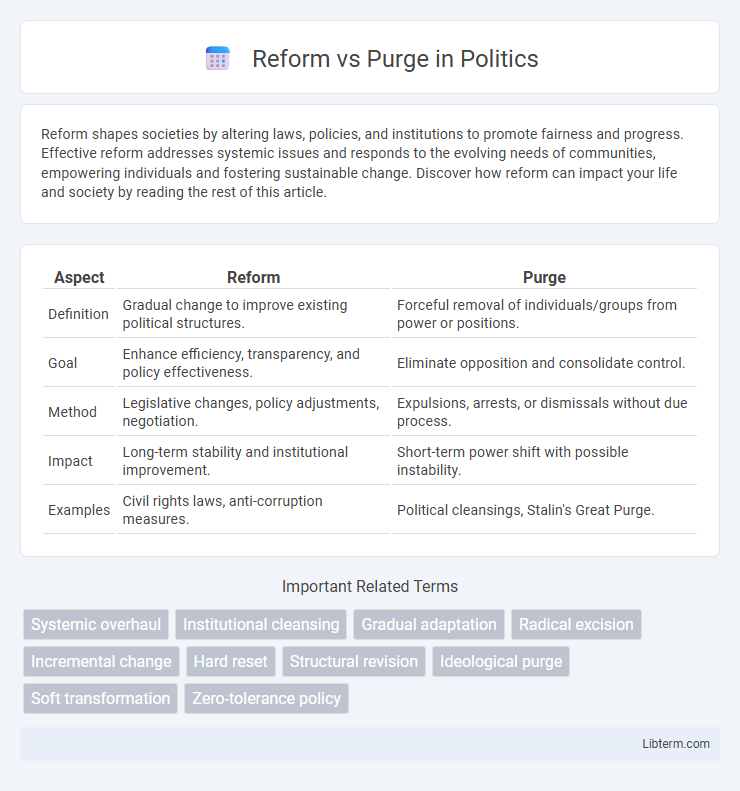Reform shapes societies by altering laws, policies, and institutions to promote fairness and progress. Effective reform addresses systemic issues and responds to the evolving needs of communities, empowering individuals and fostering sustainable change. Discover how reform can impact your life and society by reading the rest of this article.
Table of Comparison
| Aspect | Reform | Purge |
|---|---|---|
| Definition | Gradual change to improve existing political structures. | Forceful removal of individuals/groups from power or positions. |
| Goal | Enhance efficiency, transparency, and policy effectiveness. | Eliminate opposition and consolidate control. |
| Method | Legislative changes, policy adjustments, negotiation. | Expulsions, arrests, or dismissals without due process. |
| Impact | Long-term stability and institutional improvement. | Short-term power shift with possible instability. |
| Examples | Civil rights laws, anti-corruption measures. | Political cleansings, Stalin's Great Purge. |
Understanding Reform: Gradual Change Explained
Understanding reform involves recognizing it as a process of gradual change aimed at improving existing systems, structures, or policies without completely dismantling them. Reform focuses on incremental adjustments, often through legislation, education, or policy updates, to address specific issues while maintaining overall stability. This approach contrasts sharply with purges, which seek rapid, often forceful removal of elements deemed problematic, risking disruption in favor of swift transformation.
What is a Purge? Defining Radical Overhaul
A purge refers to a radical overhaul involving the complete removal of individuals, policies, or practices deemed undesirable within an organization or system. It often entails abrupt and comprehensive changes aimed at eliminating corruption, dissent, or inefficiency, contrasting with gradual reform processes. Purges can significantly disrupt existing structures by enforcing a stark break from previous norms and leadership.
Historical Context: Notable Reforms vs Major Purges
Notable reforms such as the Meiji Restoration in Japan and the New Deal in the United States transformed political and economic structures, fostering modernization and social welfare during periods of national crisis. In contrast, major purges like Stalin's Great Purge in the Soviet Union and China's Cultural Revolution involved widespread political repression, targeting perceived enemies to consolidate power and enforce ideological conformity. These historical events demonstrate how reforms aim to rebuild and progress societies, while purges often lead to instability and fear through aggressive suppression.
Key Motivations: Why Choose Reform or Purge?
Reform aims to improve existing systems by addressing inefficiencies, promoting inclusivity, and fostering gradual change to maintain stability and continuity. Purge seeks to eliminate corruption or harmful elements swiftly, often driven by urgency to restore order or ideological purity, prioritizing radical transformation over incremental progress. Choosing reform or purge depends on factors like the severity of systemic issues, desired speed of change, and tolerance for disruption within a society or organization.
Impact on Institutions: Stability vs Disruption
Reform strengthens institutions by promoting gradual improvements and preserving organizational stability, which fosters trust and continuity in governance. Purge leads to abrupt changes, often causing significant disruption and instability due to the removal of key personnel and abrupt policy shifts. The long-term impact of reform generally supports institutional resilience, whereas purges can undermine institutional integrity and create power vacuums.
Public Perception: Trust in Reform vs Fear of Purge
Public perception heavily favors reform as a pathway to restoring trust by promoting transparency, accountability, and gradual improvement within institutions. Fear of purge often undermines confidence due to its association with instability, authoritarian control, and potential abuse of power. Trust in reform generally encourages civic engagement, whereas fear of purge risks alienating the public and fostering resistance.
Political Consequences: Winners and Losers
Reform often results in a balanced redistribution of power that can create new political coalitions and weaken entrenched elites, leading to winners among reform advocates and moderate factions. Purge, by contrast, typically eliminates opposition abruptly, consolidating power within a ruling group while producing clear losers--often political rivals and dissenters who face exile, imprisonment, or death. The political consequences of reform promote gradual stabilization, whereas purges can provoke instability and authoritarian dominance.
Risks and Rewards: Evaluating Outcomes
Reform initiatives offer the reward of sustainable change by improving existing systems with lower risks of social disruption but may face resistance from entrenched interests, limiting their effectiveness. Purges deliver swift outcomes by removing corrupt or inefficient elements but carry significant risks, including instability, loss of expertise, and potential abuse of power. Evaluating outcomes requires balancing the immediate impact of purges against the gradual but stable progress of reforms to determine the most viable approach for organizational or political transformation.
Case Studies: Successes and Failures
Case studies of reform versus purge reveal contrasting outcomes in governance and organizational change. Successful reforms, such as South Korea's anti-corruption measures in the early 2000s, demonstrate improved institutional transparency and public trust, whereas purges like Stalin's Great Terror resulted in widespread fear and administrative paralysis. Examining China's anti-corruption campaign under Xi Jinping highlights a blend of reform and purge tactics, yielding enhanced party discipline but also raising concerns about political consolidation.
Choosing the Path: Reform or Purge in the Modern Era
Choosing between reform and purge in the modern era hinges on balancing institutional stability with the need for change; reform facilitates gradual improvements through policy adjustments and stakeholder engagement, preserving organizational structure. Purge, while more radical, targets eliminating corrupt or dysfunctional elements swiftly to reset systems, but risks destabilization and backlash. Effective decision-making requires evaluating the specific context, potential impacts on governance, and long-term societal goals.
Reform Infographic

 libterm.com
libterm.com